Abstract
Isolated rat neural lobes were stimulated electrically and the release of vasopressin and oxytocin was measured by radioimmunoassay. The neurohypophyses were stimulated with pulses given at a constant frequency or with a pulse pattern imitating the electrical activity, recorded in vivo, of vasopressin- or oxytocin-containing magnocellular neurones. A single burst recorded from a 'vasopressin' cell with an intraburst mean frequency of 13 Hz evoked more vasopressin release than the same number of stimuli delivered at a constant frequency of 13 Hz. The amount of vasopressin release per pulse was much higher at the beginning than at the end of the burst. Series of bursts given with interburst silent periods released more hormone than bursts delivered without silent periods. The amount of hormone released by four 'vasopressin' bursts was significantly larger with silent periods of 21 s than with shorter intervals. Four pulses were much more effective in promoting hormone release when given with 60 ms interspike intervals at the beginning of each second than when delivered at a constant frequency of 4 Hz. Prolonged stimulation with 'vasopressin' bursts had a greater effect in inducing hormone release than the same number of pulses given in burst delivered at a constant frequency of 13 Hz. After an initial increase the rate of vasopressin release declined rapidly whereas oxytocin release remained elevated for the first 20 min and only then decreased. The release of both vasopressin and oxytocin remained, however, above the release from unstimulated neurohypophyses. 45Ca uptake in the neural lobe was larger when the neurohypophyses were stimulated with vasopressin or oxytocin bursts delivered with silent intervals than when the silent periods were omitted, or when the tissue was stimulated with bursts with the same number of pulses but given at a constant frequency of 13 Hz. In conclusion, it is suggested that the interspike intervals in a burst and the silent intervals between bursts are two important determinants of the effectiveness of the burst pattern in promoting neuropeptide release.
Full text
PDF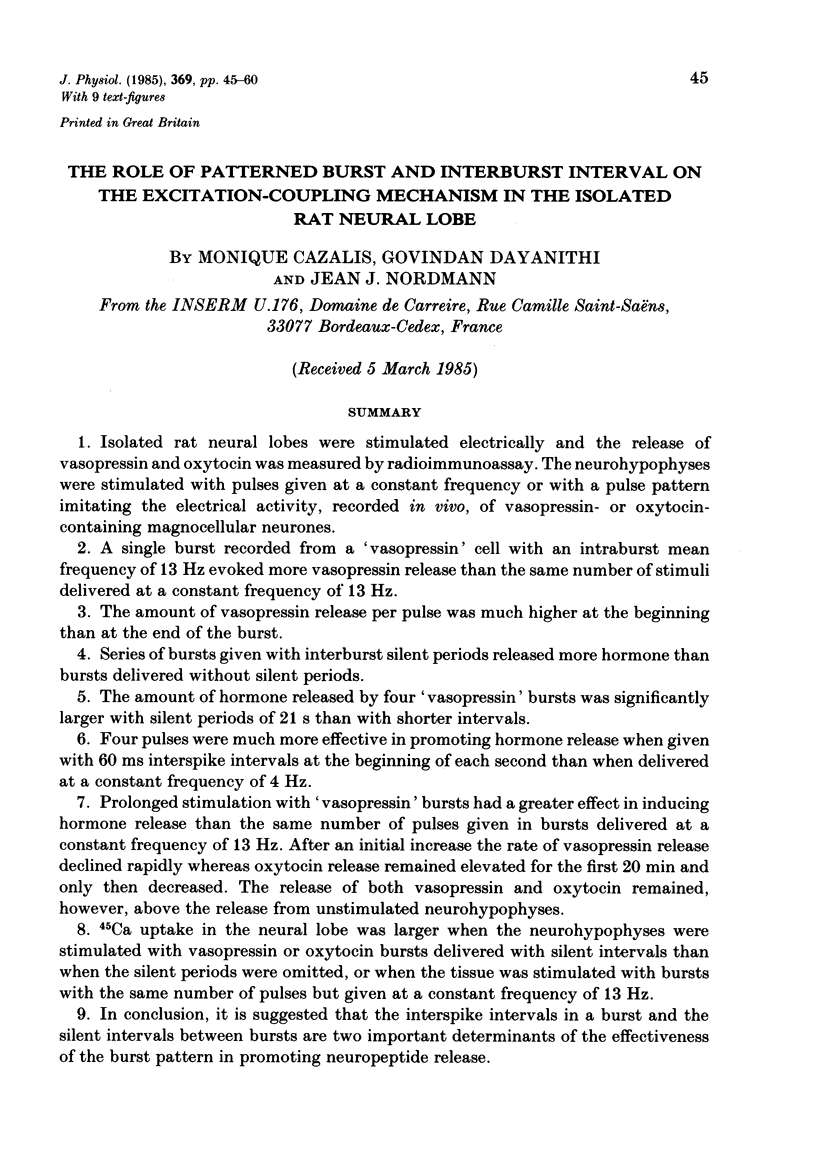
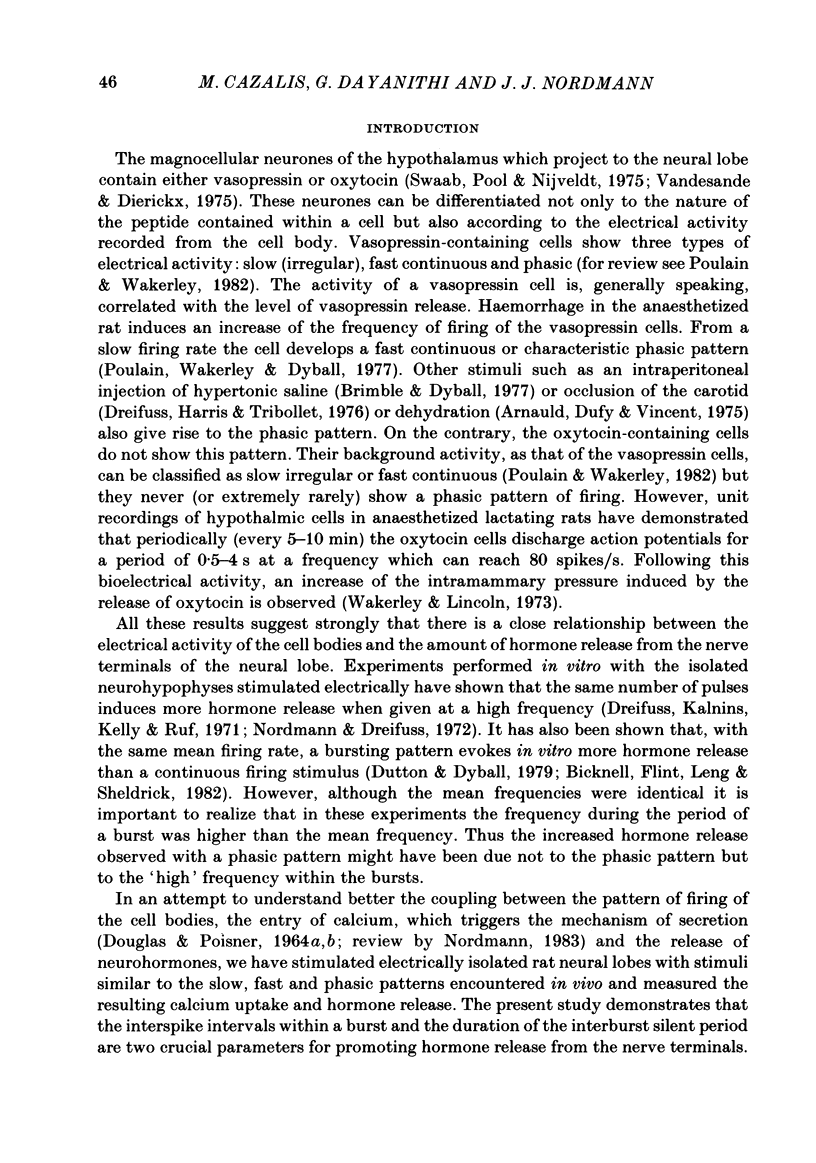
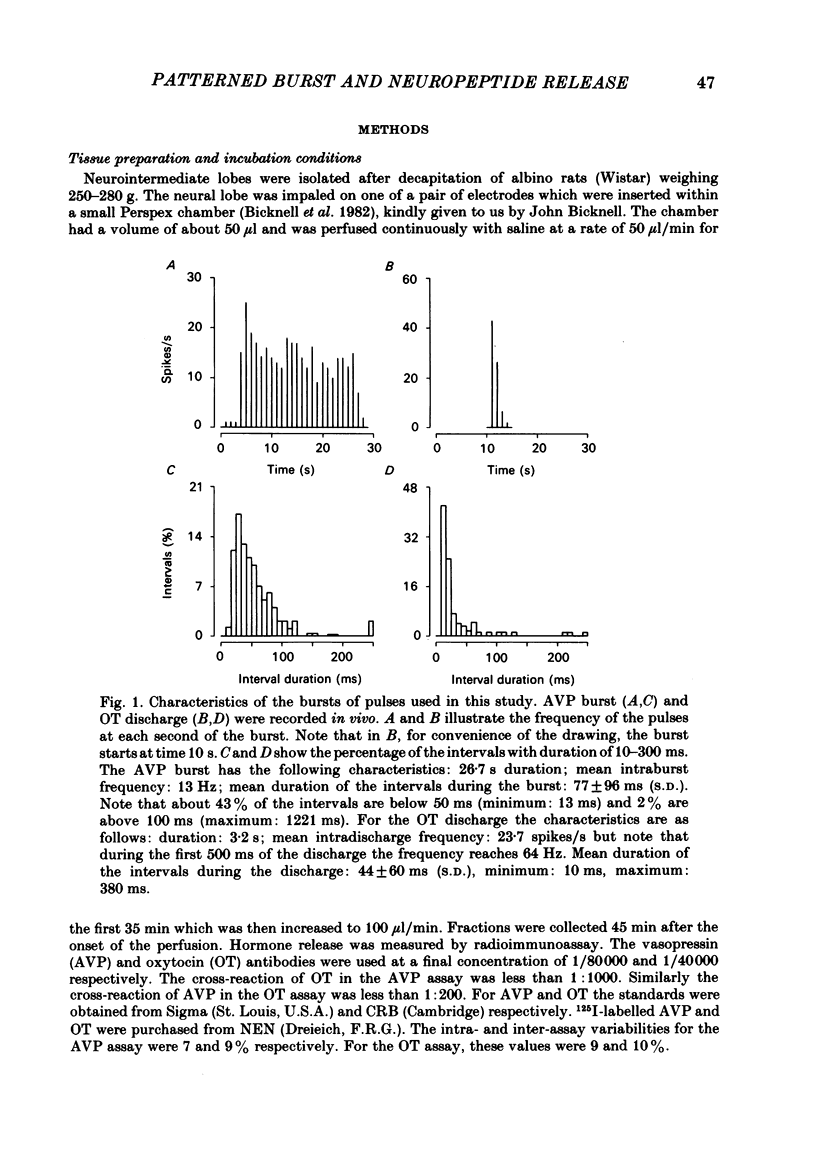
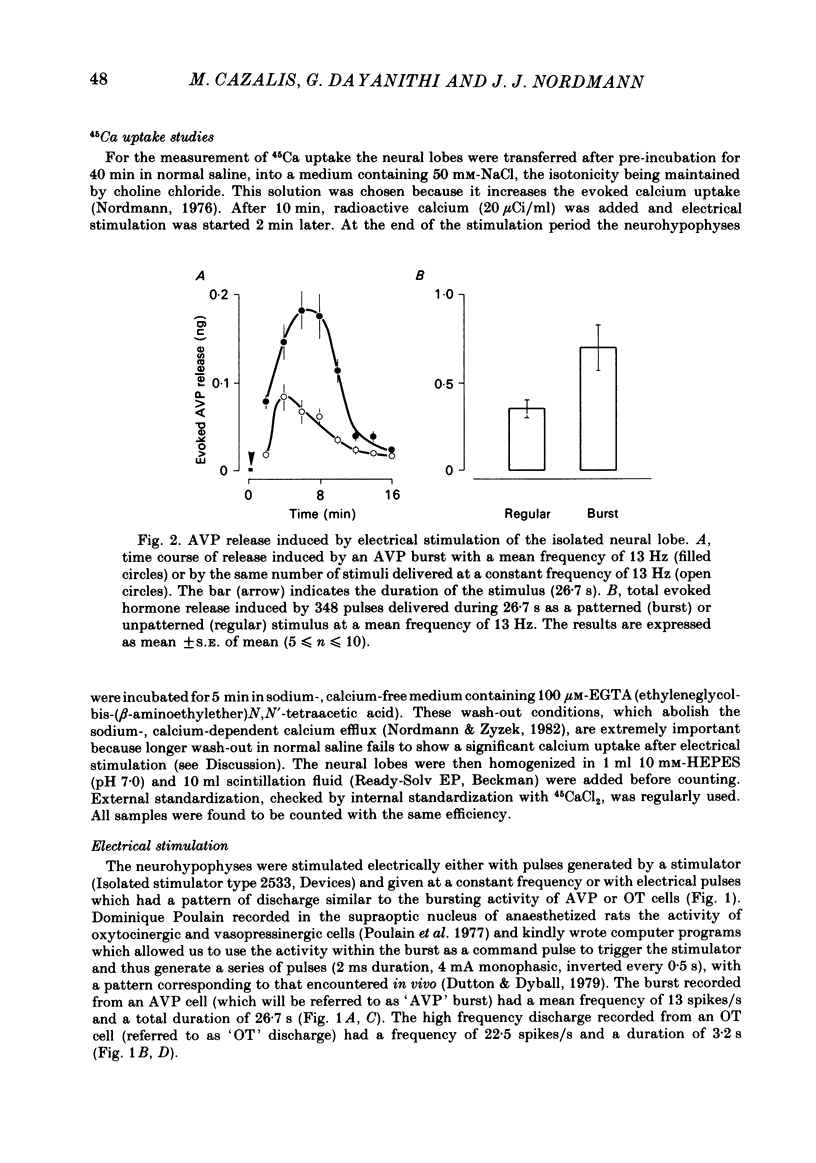

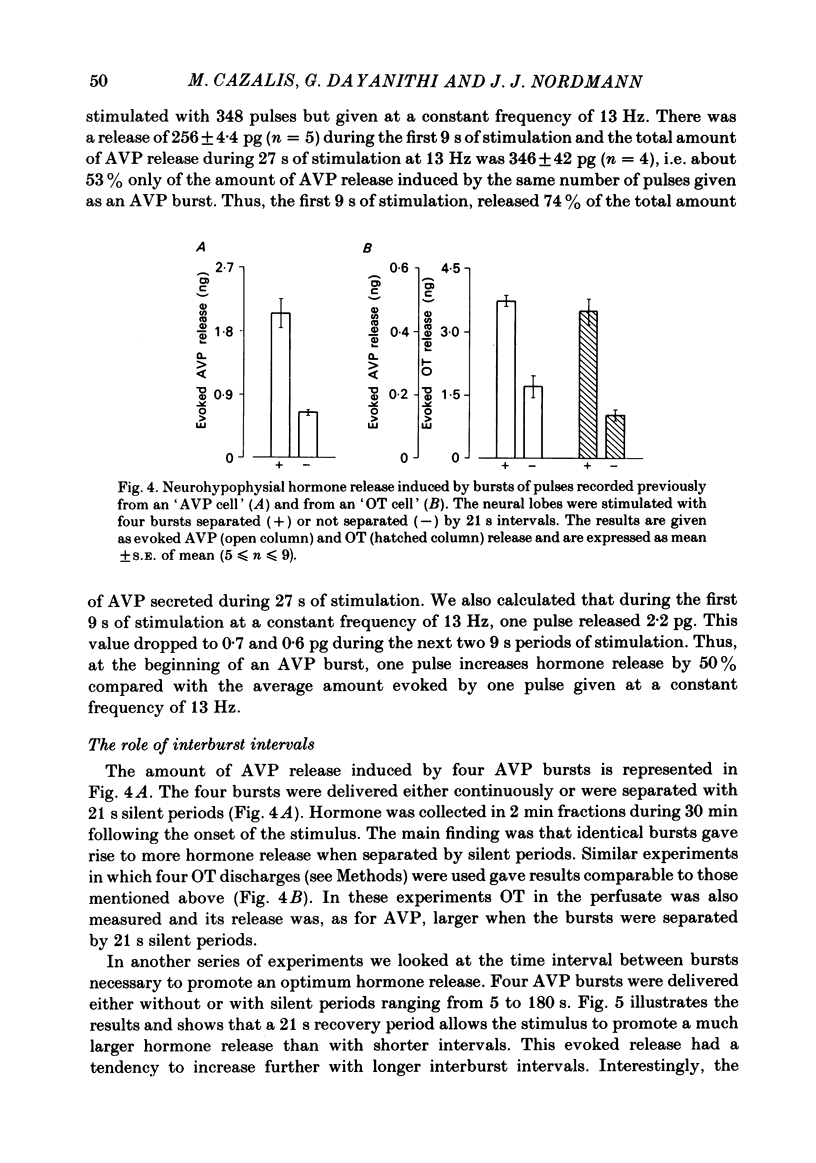
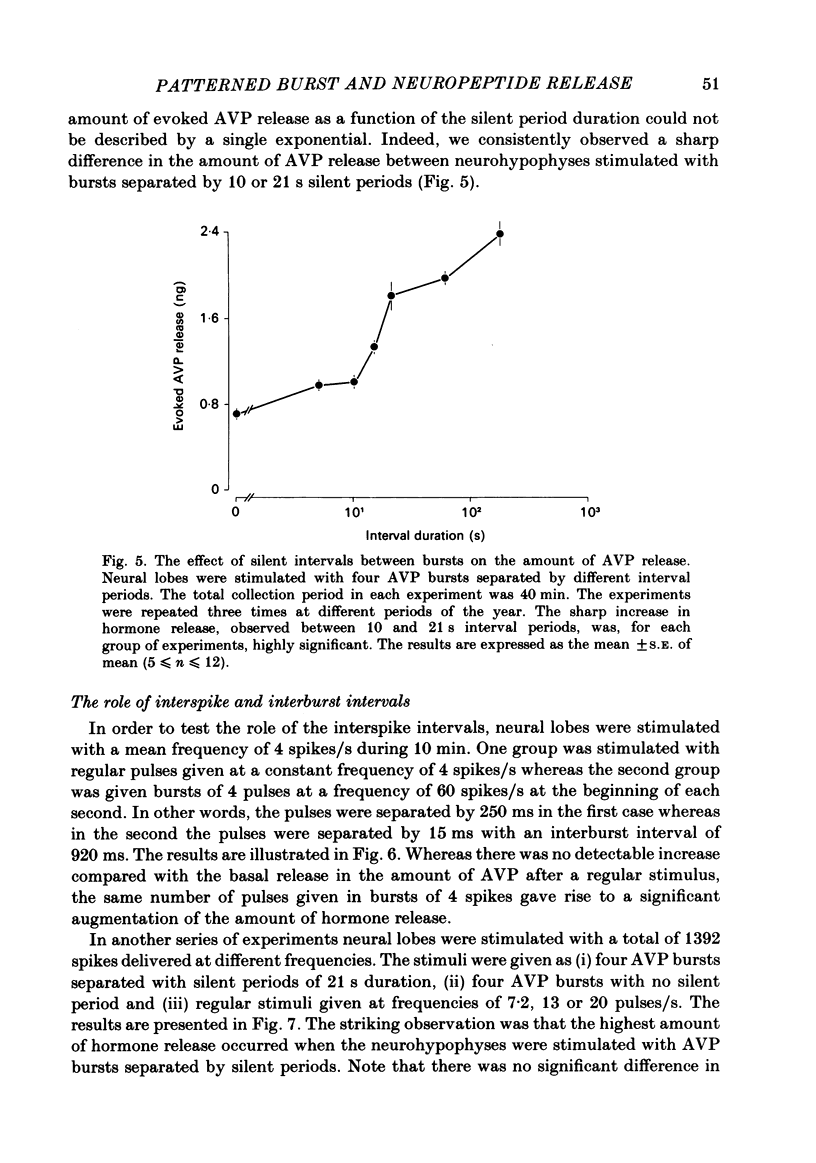
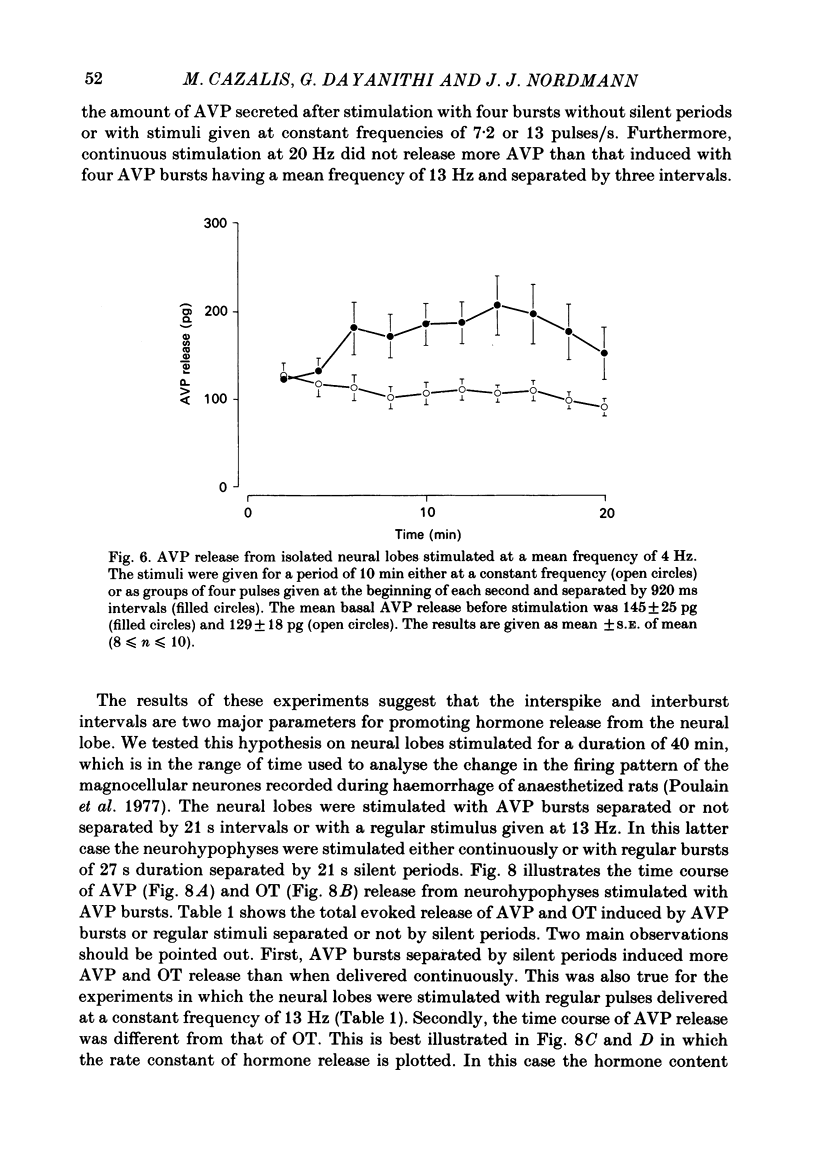
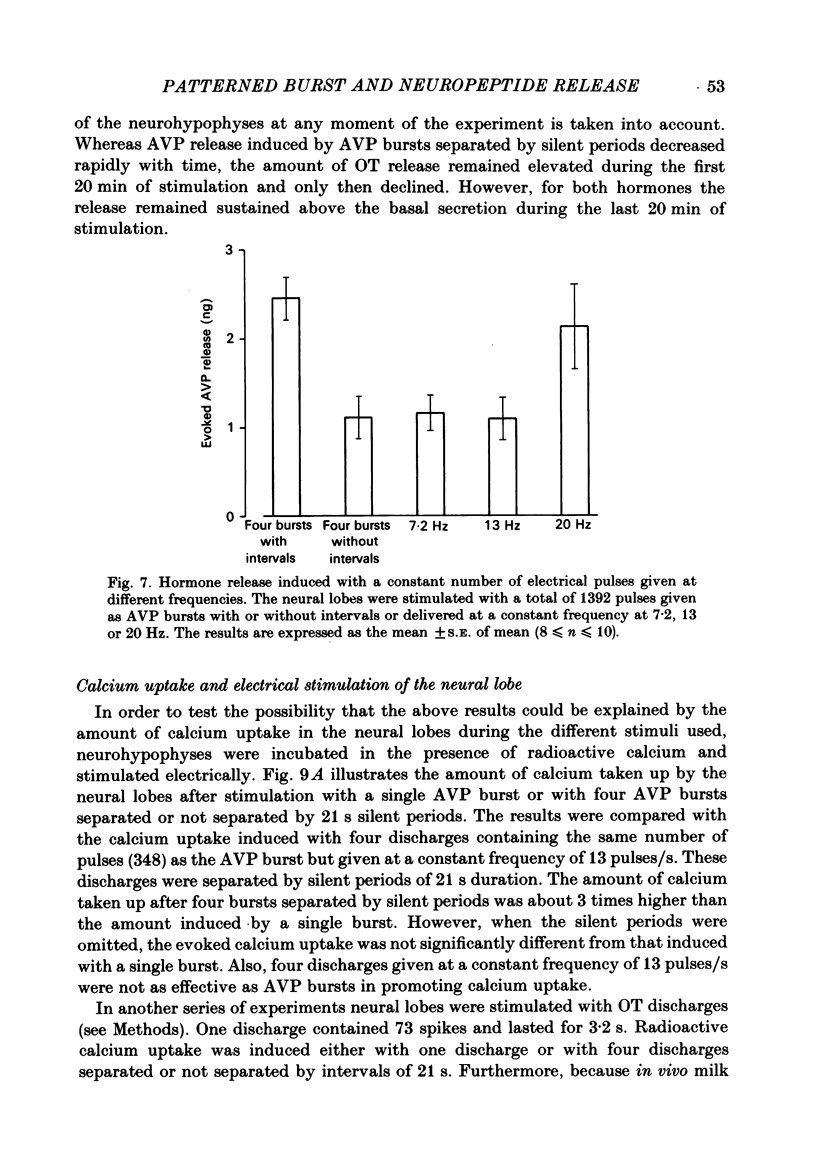

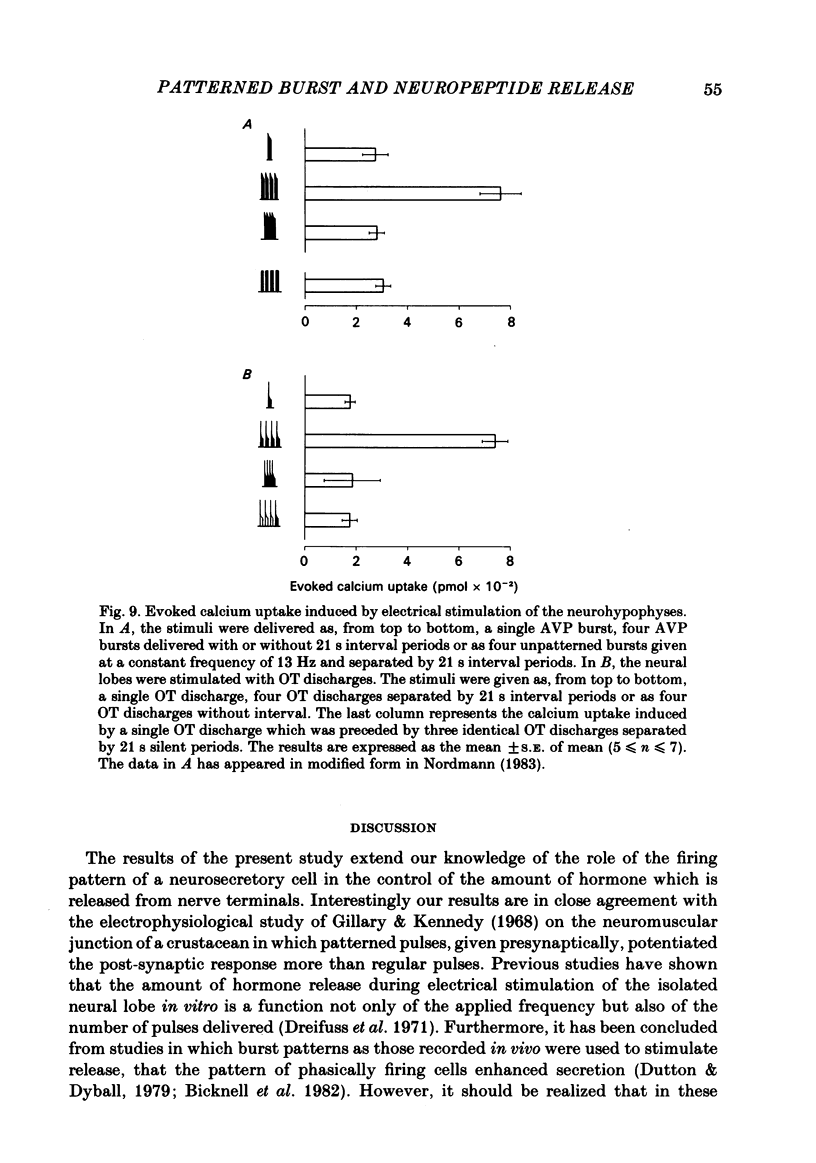

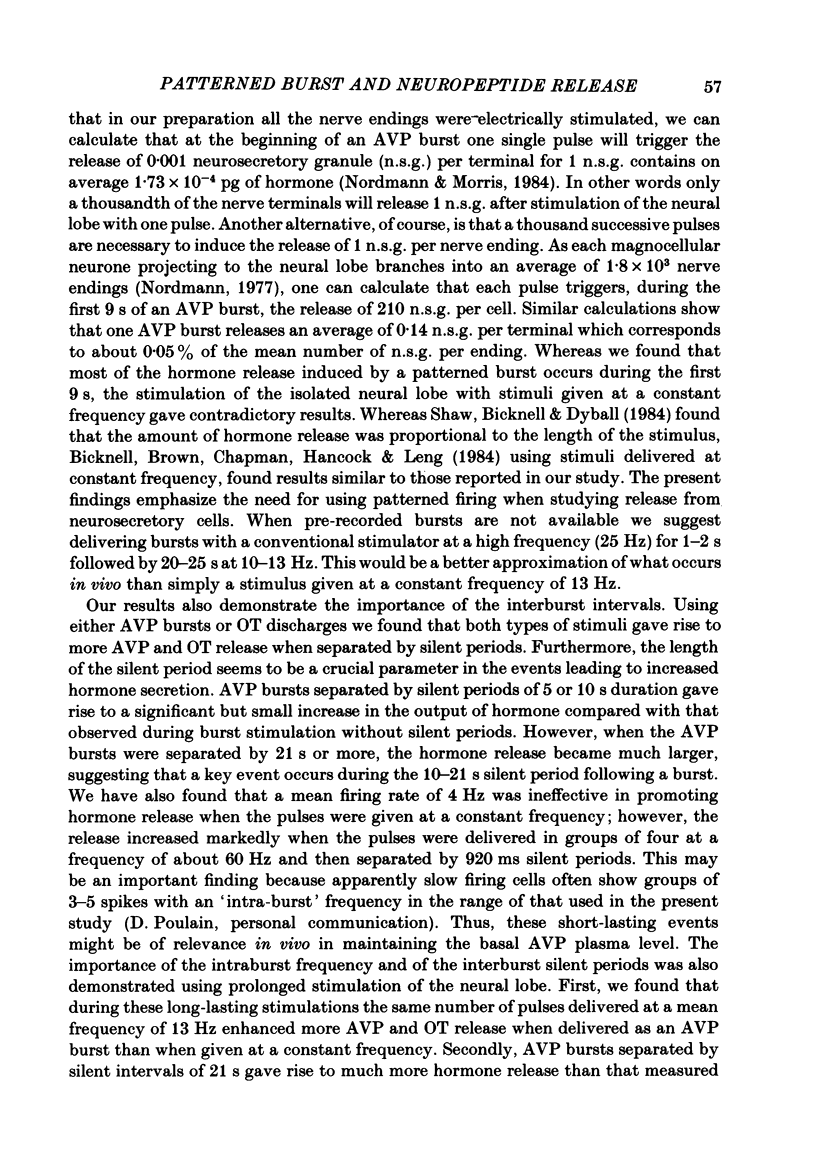
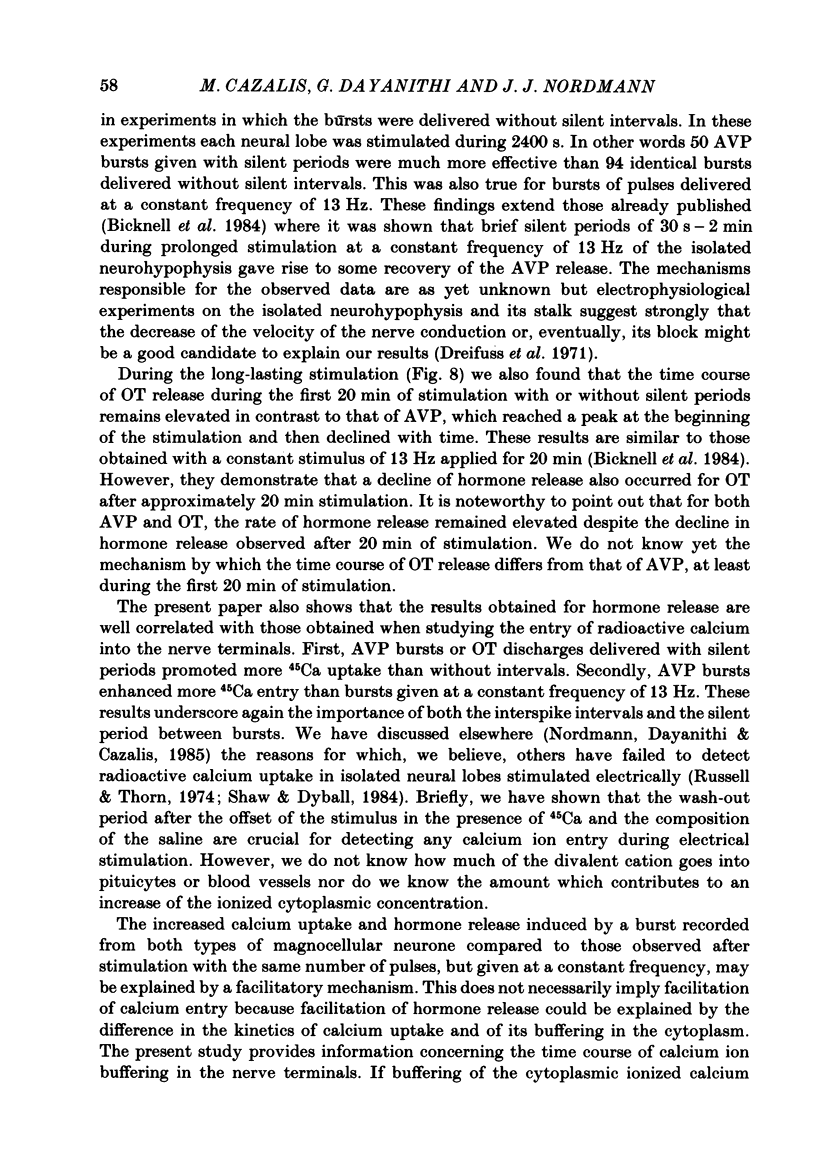
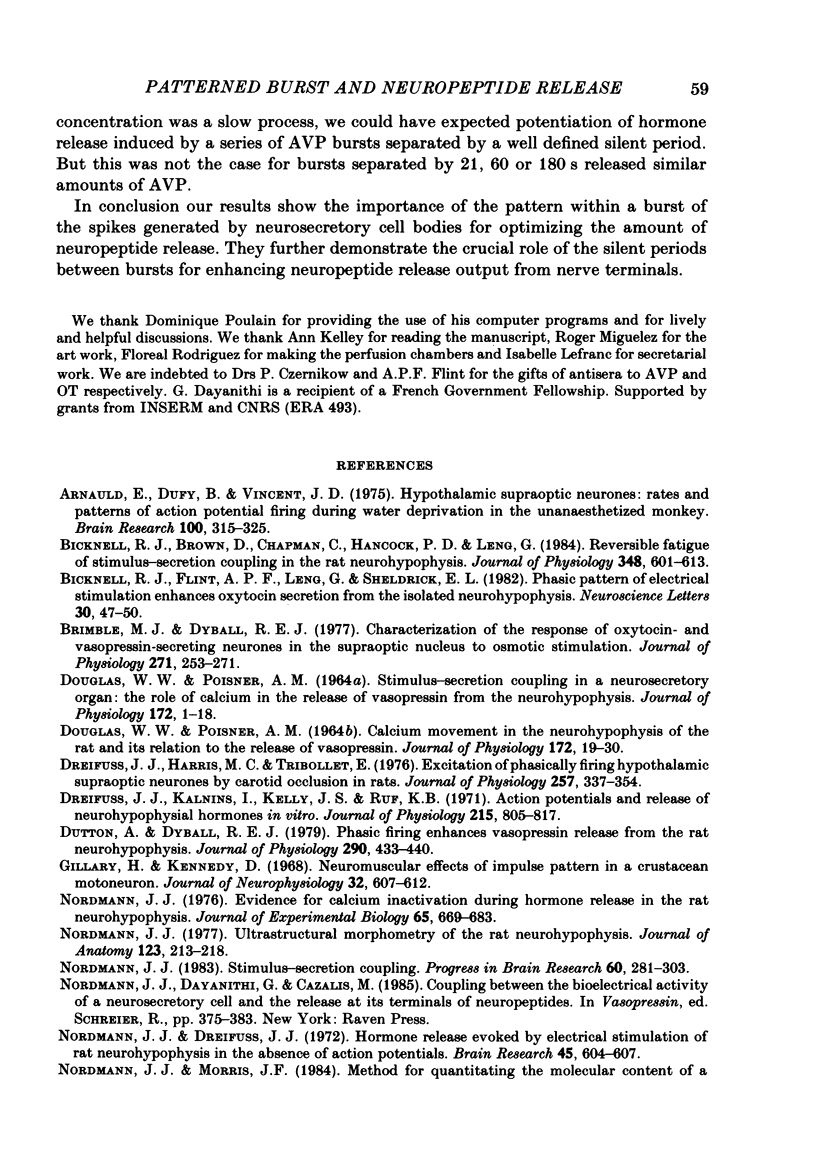
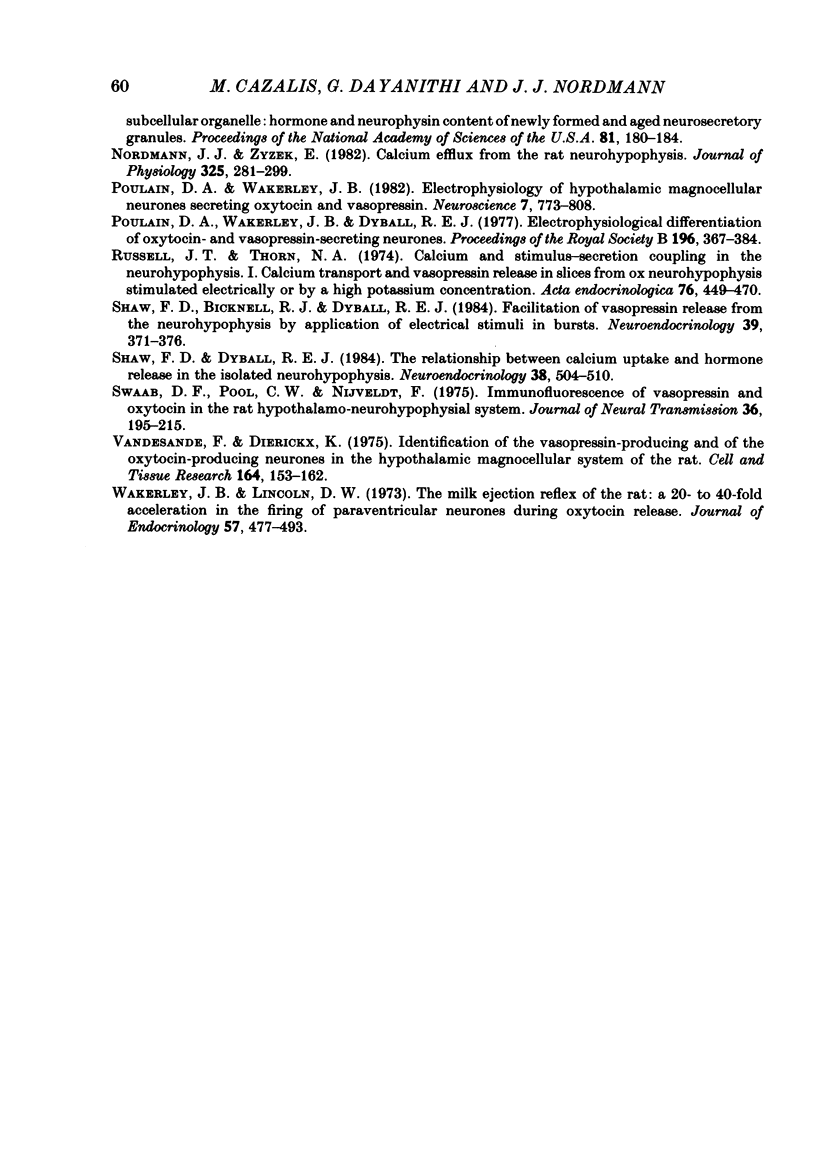
Selected References
These references are in PubMed. This may not be the complete list of references from this article.
- Arnauld E., Dufy B., Vincent J. D. Hypothalamic supraoptic neurones: rates and patterns of action potential firing during water deprivation in the unanaesthetized monkey. Brain Res. 1975 Dec 19;100(2):315–325. doi: 10.1016/0006-8993(75)90485-0. [DOI] [PubMed] [Google Scholar]
- Bicknell R. J., Brown D., Chapman C., Hancock P. D., Leng G. Reversible fatigue of stimulus-secretion coupling in the rat neurohypophysis. J Physiol. 1984 Mar;348:601–613. doi: 10.1113/jphysiol.1984.sp015128. [DOI] [PMC free article] [PubMed] [Google Scholar]
- Brimble M. J., Dyball R. E. Characterization of the responses of oxytocin- and vasopressin-secreting neurones in the supraoptic nucleus to osmotic stimulation. J Physiol. 1977 Sep;271(1):253–271. doi: 10.1113/jphysiol.1977.sp011999. [DOI] [PMC free article] [PubMed] [Google Scholar]
- DOUGLAS W. W., POISNER A. M. CALCIUM MOVEMENT IN THE NEUROHYPOPHYSIS OF THE RAT AND ITS RELATION TO THE RELEASE OF VASOPRESSIN. J Physiol. 1964 Jul;172:19–30. doi: 10.1113/jphysiol.1964.sp007400. [DOI] [PMC free article] [PubMed] [Google Scholar]
- DOUGLAS W. W., POISNER A. M. STIMULUS-SECRETION COUPLING IN A NEUROSECRETORY ORGAN: THE ROLE OF CALCIUM IN THE RELEASE OF VASOPRESSIN FROM THE NEUROHYPOPHYSIS. J Physiol. 1964 Jul;172:1–18. doi: 10.1113/jphysiol.1964.sp007399. [DOI] [PMC free article] [PubMed] [Google Scholar]
- Dreifuss J. J., Harris M. C., Tribollet E. Excitation of phasically firing hypothalamic supraoptic neurones by carotid occlusion in rats. J Physiol. 1976 May;257(2):337–354. doi: 10.1113/jphysiol.1976.sp011372. [DOI] [PMC free article] [PubMed] [Google Scholar]
- Dreifuss J. J., Kalnins I., Kelly J. S., Ruf K. B. Action potentials and release of neurohypophysial hormones in vitro. J Physiol. 1971 Jul;215(3):805–817. doi: 10.1113/jphysiol.1971.sp009499. [DOI] [PMC free article] [PubMed] [Google Scholar]
- Dutton A., Dyball R. E. Phasic firing enhances vasopressin release from the rat neurohypophysis. J Physiol. 1979 May;290(2):433–440. doi: 10.1113/jphysiol.1979.sp012781. [DOI] [PMC free article] [PubMed] [Google Scholar]
- Gillary H. L., Kennedy D. Neuromuscular effects of impulse pattern in a crustacean motoneuron. J Neurophysiol. 1969 Jul;32(4):607–612. doi: 10.1152/jn.1969.32.4.607. [DOI] [PubMed] [Google Scholar]
- Nordmann J. J., Dreifuss J. J. Hormone release evoked by electrical stimulation of rat neurohypophyses in the absence of action potentials. Brain Res. 1972 Oct 27;45(2):604–607. doi: 10.1016/0006-8993(72)90491-x. [DOI] [PubMed] [Google Scholar]
- Nordmann J. J. Evidence for calcium inactivation during hormone release in the rat neurohypophysis. J Exp Biol. 1976 Dec;65(3):669–683. doi: 10.1242/jeb.65.3.669. [DOI] [PubMed] [Google Scholar]
- Nordmann J. J., Morris J. F. Method for quantitating the molecular content of a subcellular organelle: hormone and neurophysin content of newly formed and aged neurosecretory granules. Proc Natl Acad Sci U S A. 1984 Jan;81(1):180–184. doi: 10.1073/pnas.81.1.180. [DOI] [PMC free article] [PubMed] [Google Scholar]
- Nordmann J. J. Stimulus-secretion coupling. Prog Brain Res. 1983;60:281–304. doi: 10.1016/S0079-6123(08)64397-6. [DOI] [PubMed] [Google Scholar]
- Nordmann J. J. Ultrastructural morphometry of the rat neurohypophysis. J Anat. 1977 Feb;123(Pt 1):213–218. [PMC free article] [PubMed] [Google Scholar]
- Nordmann J. J., Zyzek E. Calcium efflux from the rat neurohypophysis. J Physiol. 1982 Apr;325:281–299. doi: 10.1113/jphysiol.1982.sp014150. [DOI] [PMC free article] [PubMed] [Google Scholar]
- Poulain D. A., Wakerley J. B., Dyball R. E. Electrophysiological differentiation of oxytocin- and vasopressin-secreting neurones. Proc R Soc Lond B Biol Sci. 1977 Apr;196(1125):367–384. doi: 10.1098/rspb.1977.0046. [DOI] [PubMed] [Google Scholar]
- Poulain D. A., Wakerley J. B. Electrophysiology of hypothalamic magnocellular neurones secreting oxytocin and vasopressin. Neuroscience. 1982 Apr;7(4):773–808. doi: 10.1016/0306-4522(82)90044-6. [DOI] [PubMed] [Google Scholar]
- Russell J. T., Thorn N. A. Calcium and stimulus-secretion coupling in the neurohypophysis. I. 45-Calcium transport and vasopressin release in slices from ox neurohypophyses stimulated electrically or by a high potassium concentration. Acta Endocrinol (Copenh) 1974 Jul;76(3):449–470. [PubMed] [Google Scholar]
- Shaw F. D., Bicknell R. J., Dyball R. E. Facilitation of vasopressin release from the neurohypophysis by application of electrical stimuli in bursts. Relevant stimulation parameters. Neuroendocrinology. 1984 Oct;39(4):371–376. doi: 10.1159/000124007. [DOI] [PubMed] [Google Scholar]
- Shaw F. D., Dyball R. E. The relationship between calcium uptake and hormone release in the isolated neurohypophysis. A reassessment. Neuroendocrinology. 1984 Jun;38(6):504–510. doi: 10.1159/000123940. [DOI] [PubMed] [Google Scholar]
- Swaab D. F., Pool C. W., Nijveldt F. Immunofluorescence of vasopressin and oxytocin in the rat hypothalamo-neurohypophypopseal system. J Neural Transm. 1975;36(3-4):195–215. doi: 10.1007/BF01253126. [DOI] [PubMed] [Google Scholar]
- Vandesande F., Dierickx K. Identification of the vasopressin producing and of the oxytocin producing neurons in the hypothalamic magnocellular neurosecretroy system of the rat. Cell Tissue Res. 1975 Dec 2;164(2):153–162. doi: 10.1007/BF00218970. [DOI] [PubMed] [Google Scholar]
- Wakerley J. B., Lincoln D. W. The milk-ejection reflex of the rat: a 20- to 40-fold acceleration in the firing of paraventricular neurones during oxytocin release. J Endocrinol. 1973 Jun;57(3):477–493. doi: 10.1677/joe.0.0570477. [DOI] [PubMed] [Google Scholar]


